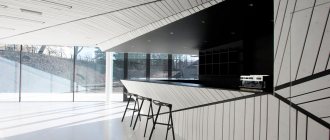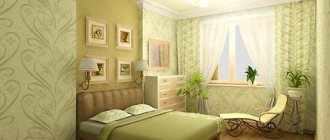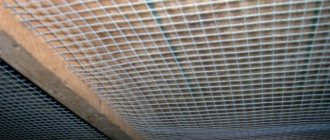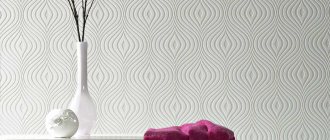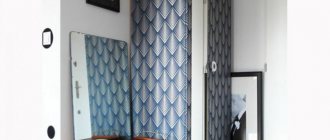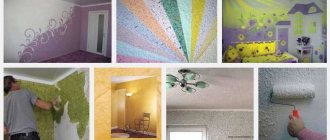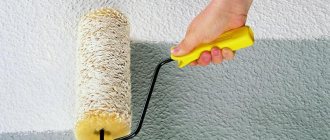The emergence of an increasing number of finishing materials serves as a reason for the formation of certain requirements for one or another type of material. Today, preference is given not only to visually attractive, but also to practical and durable coatings. Hot stamped wallpaper for walls successfully combines the above requirements.
What is hot stamping wallpaper?
Hot stamped wallpaper is a double-layer vinyl wallpaper.
- The bottom layer of this type of coating is based on paper or non-woven fabric.
- The base of the top is vinyl.
Under the influence of heat treatment, the top layer melts, forming a dense layer of foam. As a result, the material becomes more elastic, and is ready for the last stage - applying a drawing (pattern) using special figured rollers.
Comparison of two groups of embossed wallpaper
The technical characteristics of thick embossed wallpaper are based on the base used (non-woven fabric and paper). This is a major factor affecting price, quality and durability. Let's look at each category.
Nonwoven
Let's consider the advantages of roll sheets and the existing disadvantages.
New embossing technologies make wallpaper extraordinarily beautiful
Pros:
- Safety. This wallpaper is absolutely safe for humans. They do not contain harmful substances and are recommended for all types of rooms, including bedrooms. Indispensable in apartments with children and allergy sufferers.
- The “breathability” of the coating has been proven . They allow air to pass through and eliminate the possibility of mold and mildew.
- Quality . Thanks to its composition, the material does not deform after application and retains its color saturation for many years.
- Design. The variety of textures, patterns and palettes attract attention. Non-woven wallpaper can decorate any interior and hide defects on complex surfaces (except for silk-screen printing).
Silkscreen printing impresses with the play of color
- Decorating possibilities . Many types can be painted. Under the influence of paint, the base does not change, but the structure becomes denser.
- Versatility. Wallpaper with embossing is suitable for walls made of plasterboard, chipboard, wood and concrete.
- Dismantling. No soaking or scraping required. The canvas is easily separated from any surface.
- Quick installation (roll width is one meter).
- Long service life - 9–12 years.
Vinyl embossing offers a large selection of designs
Minuses:
The number of strengths can be compared with the only disadvantage. Vinyl wallpaper that does not have additional coating (varnish, paint) cannot be washed. Dry cleaning with a vacuum cleaner is acceptable.
Non-woven wallpaper is much more expensive than paper wallpaper. To save money, it is recommended to use a small pattern in large rooms. Otherwise, each roll will take 1–2 meters to pick up.
Non-woven base is moisture resistant - used in the bathroom
Paper
Paper-based embossed vinyl has its strengths and weaknesses. In general, this group loses to non-woven ones. Heavy vinyl (duplex) is considered the highest quality.
Advantages:
- Minor camouflage effect (small cracks, roughness).
- Contribute to the creation of a favorable microclimate.
- Environmentally friendly.
- Not exposed to UV rays.
- Low price.
Flaws:
- Can't be washed.
- Cannot be used in damp areas.
- Low resistance to stains.
- With increased parking, mold/fungus appears on the paper.
- Difficult installation - you need to apply glue to the canvas and the wall. There are a lot of seams, since the rolls are 53 cm long.
- Short service life - 5 years.
Advantages and disadvantages
Let's consider the advantages of this coating.
- Long service life. Paper wallpaper will serve you for at least 8-12 years, its non-woven counterpart - from 20 years.
- Moisture resistance. This wallpaper is “not afraid of moisture.” They can be used both when finishing the kitchen area and the corridor.
- Easy to care for. You can even use a regular kitchen sponge and dishwashing detergent to clean wallpaper. You can use a damp towel to remove any dust accumulated on the drawing.
- Resistant to direct sunlight. Hot stamped wallpaper does not fade or fade in the sun.
- Soundproofing. The non-woven fabric at the base of the covering and the porous shape of the wallpaper conceal sounds.
- Visually straighten crooked walls. A three-dimensional pattern on the wallpaper allows you to hide small unevenness on the wall.
- Quite a varied selection of textures.
Let's also pay attention to the disadvantages:
- Unresistant to mechanical stress. Due to its rough surface, the three-dimensional pattern does not “tolerate” children, animals, or children’s vehicles well.
- Artificial base. Due to the fact that vinyl is not a natural material, its quality characteristics in terms of environmental friendliness and toxicity are inferior to conventional paper wallpaper.
- The walls don't "breathe". The dense layer of vinyl in the base significantly slows down the ventilation of air between the wall and the covering, which is likely to lead to the formation of mold.
- Difficulties with gluing. Thanks to the double layer, hot-stamped wallpaper has a decent weight, which complicates the gluing process.
- Price. The price range for such coverage is quite wide. For really high-quality wallpaper you will have to pay a lot. Please note that you should not save on non-woven fabrics. However, the price of paper wallpaper fluctuates around 500 rubles. per roll.
Production of embossed wallpaper
Wallpaper with a refined texture is called embossed. The product received its name due to its production technology, which includes the following aspects:
- Drawing detailed print. Thin patterned transitions are applied to the paper layer, forming a unique optical illusion.
- Laminating. The protective layer is glued to the decorative glue.
- The embossing process itself. The layers glued together are passed through a steel fastening machine.
- Complete drying of the material.
- Cutting the fabric into specific sizes and forming rolls.
At the moment, technology has reached such a point that embossed wallpaper is made not only from a paper base, but also from non-woven and vinyl. The technique of their production is slightly different from that listed above, but the essence is almost the same.
Types of hot stamping wallpaper
Among the many options for this coating, the following varieties can be distinguished.
- Silkscreen printing . This coating is quite thin, which is explained by a small layer of polyvinyl chloride. Silk-screen printing allows you to create a three-dimensional effect due to silk fabric and shimmer with sparkles. However, it is suitable for a room with perfectly smooth walls.
- Contact vinyl . The exact opposite of silk-screen printing - the vinyl layer is quite thick, which adds significant weight to the coating. Contact vinyl has a relief structure, thanks to which it can imitate brick, fabric, leather and other natural materials.
- Double layer vinyl (heavy vinyl) . Much denser than contact vinyl and has a pronounced pattern.
- Chemical embossing. A special agent, inhibitors, is applied to the vinyl layer along the outline of the pattern, resulting in the formation of a three-dimensional pattern on the wallpaper.
Varieties
There are several different popular solutions that are produced using the hot stamping method. They (with some exceptions) have fairly similar technical characteristics, but the appearance is usually quite different.
The combination of black and white will create a high-quality interior
- The first type is silk-screen printing, which produces a coating that resembles silk (although it is not). A special luminescent coating reflects light in a unique way, so when illuminated, a room with such wallpaper looks unique. The color range is quite limited, and the relief is not very textured, but resembles silk.
- The thickest variety is the so-called “compact vinyl”. This same variety is one of the most common. Such vinyl wallpapers weigh a lot, their texture is deep and very embossed, and the palette is the richest; you can find hundreds of shades of colors, which will allow you to ideally choose the optimal solution specifically for your interior. The texture of compact vinyl can be stylized, for example, imitating wood, brick or even leather - therefore, if you want to adhere to a certain direction in interior design, compact vinyl will come in handy.
- Inhibited vinyl is a type of compact vinyl, but processed slightly differently. Chemical embossing is also added to the manufacturing process of the latter, which adds unique characteristics to this coating. Therefore, the price of this variety is one of the highest.
Article on the topic: Design of a children's room for a girl. Photos of interiors
Increased texture of vinyl wallpaper
Color palette
Hot stamping wallpaper is rich in textures and patterns. For example, contact vinyl is more often used as an imitation of natural materials - wood, leather, brick.
In turn, among the colors of heavy vinyl, bright shades predominate. Iridescent silk-screen printing is characterized by bed pastel colors, sophisticated patterns, and monograms.
Read about fashion trends in wallpaper for walls here -
Gluing process
In the process of covering walls, it is important to consider several points. Firstly, it is the heavy weight of the wallpaper (in the case of contact vinyl and heavy vinyl). Secondly, you need to glue joint to joint, especially if there is a pattern on the wallpaper.
Please note that the success of covering vinyl wallpaper directly depends on the preliminary preparation of the wall: it must be dry and clean. Before gluing, it is advisable to remove the baseboard, switches and sockets. Always start gluing from the corner. Cut off excess pieces with a well-sharpened tool.
Cutting out the "duplex" wallpaper
If embossed paper wallpaper is intended for painting, then it has an ornament (embossing) that does not require matching on adjacent canvases. But, if a pattern is industrially applied to embossed wallpaper, then adjusting the stripes is necessary in most cases.
To do this, after checking, before unpacking the wallpaper roll, the batch number and the visual match in color and tone, simultaneously open two rolls and roll them out on a clean, flat surface so that the stripes are located next to each other.
After this, the pattern on both strips is combined and the upper edge of both strips (sometimes one) is cut off. Measure the width of the cut strip (this width is called repeat).
Measure the length of the strip exactly corresponding to the height of the room (no need to leave any allowances!). During the process of soaking and soaking with glue, the length of the wallpaper will increase and they will require slight trimming along the floor surface.
In the future, you can roll out the wallpaper along the “standard” first strip with the pattern facing up, or use a construction tape measure and measure the length of the strips, taking into account the repeat for each subsequent roll.
Before cutting, I fold heavy wallpaper in half, so that the edges are strictly parallel. After this, the bend is strongly smoothed with fingers or a smooth round object (knife handle), and only after that, holding the knife at an angle of 30-35° to the cutting plane, the strip is cut off with small translational movements.
Using scissors is inconvenient and time-consuming. Never use a retractable construction (stationery) knife with replaceable blades when cutting. They are too sharp. They can easily cut the canvas crookedly, ruining 2 whole stripes. The best option is a long kitchen knife with a thin blade, sharpened with a file before cutting.
The best manufacturers
One of the leaders in the production of hot-stamped wallpaper is Germany, namely such companies as AS Creation, Rasch and Erismann.
Italy is practically not inferior to its European neighbor - the Zambaiti and Sirpi brands are worthy competitors in the world market.
The Ukrainian factory "Eden" produces vinyl wallpaper of European quality.
Among domestic manufacturers you can find “Erisman”, “Elysium”.
Glue selection
What glue to use
Before repairing, you need to choose which glue to glue the wallpaper with. The master can purchase either a universal type composition, which will allow you to glue wallpaper on any basis, or a special glue for paper and non-woven wallpaper.
Other compositions will not be suitable, because vinyl materials have their own specifics. It is better to purchase high-quality glue and not worry about the consequences. It is better to buy compounds in trusted stores to avoid counterfeits.
In the interior of different rooms
Hot stamping wallpaper is perfect for the design of any room. For example, pastel colors of silk-screen printing will decorate the bedroom, and patterns and monograms will add tenderness and sophistication to the room. However, dark compact vinyl will provide a more relaxed atmosphere in the room.
The nursery and kitchen will be decorated with bright colors such as yellow, green, pink, turquoise, blue. However, it is better to combine several shades. For the kitchen, you can also use imitation stone or brickwork.
In the living room, the best option would be a predominance of metallic tones, which in turn will give the room a sense of conceptuality and spaciousness. Stylized furniture is an ideal complement.
Learn more about wallpaper for the living room.
Where to glue
Where vinyl wallpaper is appropriate
Vinyl wallpaper can be hung anywhere. However, if you take into account their characteristics, you can indicate specific places where they will be indispensable. This material is perfect for the hallway. Usually repairs are made here taking into account the fact that dirt from the street will certainly get on the walls and floor.
Vinyl wallpaper is very resistant to moisture, in addition, it can be washed. One wet cleaning and there will be no dirt. Therefore, when once again considering the renovation of a corridor or hallway, you should definitely consider vinyl wallpaper as a finishing option.
Such materials are also suitable for rooms where there is a high risk of high humidity. They can be used in public places where there is a risk of contamination. However, wallpapering is also done in ordinary apartments. After all, vinyl wallpaper looks great.
Vinyl wallpapers are divided into two more types:
- wallpaper without embossing;
- wallpaper with hot stamping.
Some people ask how to glue embossed vinyl wallpaper and whether this process is different from gluing other vinyl materials. At its core, the process is not very different, although some subtleties in the work will have to be taken into account.
Photo collection
A few more gluing options that you can do at home.
